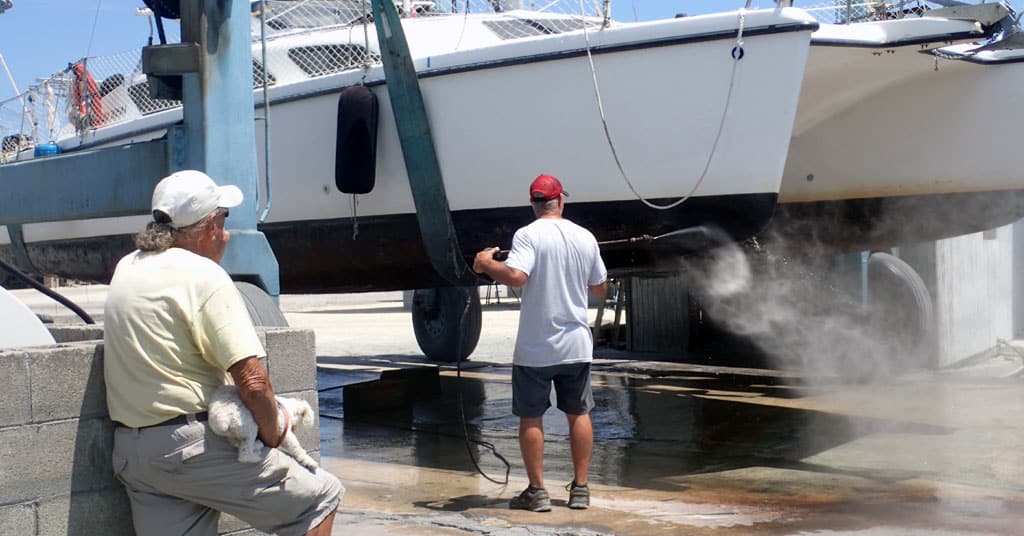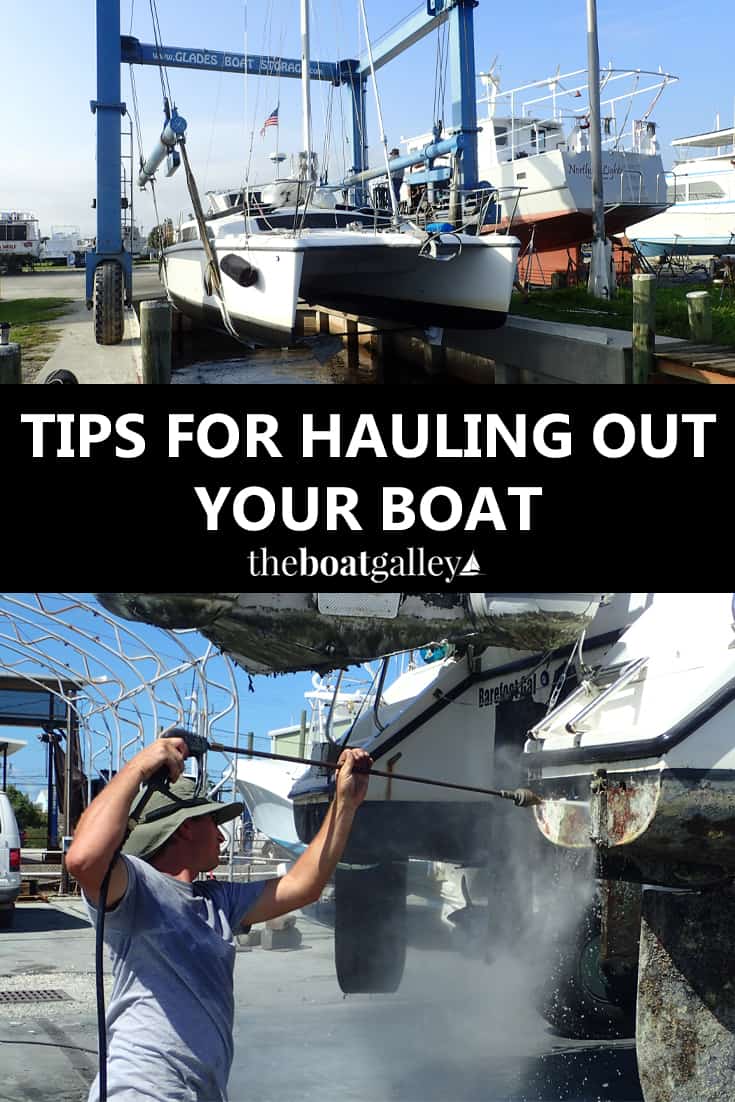Hauling out your boat. it’s never fun. But it is necessary for routine maintenance like bottom painting and under-the-waterline repairs. Here are some of my best tips.
Before You Haul Out your Boat
Don’t assume you’ll think of everything the day your haul-out is scheduled. A little forethought helps. Here’ are a few things to consider.
- Know where the lift points (sling positions) are for your boat. Mark them with tape so that the crane operator can see them. Or at least have a side picture of your boat in slings so the operator can see the position. You can find this information in your boat manual (if you have one). Or ask in your boat make’s user group online.
- If possible, check out the entrance channel and TravelLift well before the haul out day. Hauling out is stressful enough. Knowing the dockage and how you’ll enter the TravelLift makes it a lot easier.
- Most yards want you off the boat while the boat is being lifted and pressure washed. Be prepared to be off the boat for several hours when you step off. Grab your shoes, purse, wallet, dog, water bottle, hat, sunglasses and anything else you may need. It’s best to pack a go-bag the day before.
- If you have a watermaker, decide if you’re going to pickle it before hauling out or if you’ll do freshwater flushes. If fresh water flushing, be sure you can de-chlorinate tap water if you have to use it (charcoal block filter will do it).
Haul-Out Boat Jobs
Hauling a boat is expensive. Plan ahead to make the most of your time on the hard.
- Create a list of jobs to complete. What will the yard do and what will you do?
- Know what jobs have to be done before others. If you have a rain day, what work can you still do?
- Think your projects through and get parts and supplies ahead of time. There will still be some surprises, but minimizing the trips to the store makes work go much faster!
- And speaking of surprises, count on a couple. We’ve never had a haul out where we didn’t discover extra work that we needed to do. Of course, a broken bolt or other mishap can also cause delays. Accept it as part of the deal.
- If you’re doing any appreciable part of the work yourself, you’re likely to be tired (okay, exhausted) at the end of the day. Plan easy meals and stock up on groceries before hitting the yard. Eating out is also an option but there are days when I’m just so tired I don’t feel like going anywhere.
- Learn the names of the yard employees working on your boat and make a point to exchange pleasantries with them. Offer a cold drink if it’s hot. You’ll be surprised at how much more smoothly your work goes.
- Right before re-launching (hopefully, just a couple of hours before), wash the deck of the boat one final time. Boatyards are dirty places and you’ll be surprised how much dirt comes off even if you washed it the day before.
Life While Hauled Out
If you will be living on your boat while it’s on stands, you have a few extras to consider.
- Do you know how to enter or exit the yard after hours? Make sure you ask before you get stuck outside a locked gate.
- Know where to get water and power. There may be separate faucets for drinking water and boat washing.
- Is there a key or code for the bathroom and showers?
- Tie the ladder to the boat.
- Put an old rug or even a “rag” towel at the base of the ladder and take your shoes off before going aboard. This will keep a lot of dirt from being tracked in. Read more about Surviving Dirty Nasty Boat Projects.
- If you have a larger dog, figure out how to get it on and off the boat. If your dog is small enough to carry under one arm, it’s easy. Best is if the yard has a stairway instead of a ladder to go up and down! Otherwise, you’ll have to rig a harness and lifting mechanism.
- Are you allowed to grill while on the hard? Many yards allow gas grilling but not charcoal due to the fire hazard.
- In the middle of the night, you’ll appreciate a composting head.
Cruiser’s Tips
Of course, other boat owners have great tips as well. Lindsey suggested you think about areas of the boat that might need more protection. For example, a giant rub rail that could bend or new paint. If so, ask the yard if they can insert blocks covered in carpet between the hull and the slings to relieve some pressure.
Karen reminds us that you should close all inside doors while the boat in on the hard. If not, they can get out of alignment. You wouldn’t want to return to your boat and find sticky doors or doors that no longer close.
And Ernie suggests that you may save money hauling a lighter boat with a crane instead of a Travelift. It’s one option for some catamarans. Do you research in advance to see if it’s a good solution for you.
Over the years, we’ve hauled out several times. Twice we lived aboard for four months on the hard. It’s more typical to haul for a week or two to paint the bottom or do jobs the require being out of the water. Shorter haul-outs can be more challenging since you’re on a tight schedule. We tended to work from sunlight to sunset every day. Despite cruising being an active life, the physical labor of a haul out is demanding. A little pre-planning can make hauling out your boat much less stressful.
Related Posts

Carolyn Shearlock has lived aboard full-time for 17 years, splitting her time between a Tayana 37 monohull and a Gemini 105 catamaran. She’s cruised over 14,000 miles, from Pacific Mexico and Central America to Florida and the Bahamas, gaining firsthand experience with the joys and challenges of life on the water.
Through The Boat Galley, Carolyn has helped thousands of people explore, prepare for, and enjoy life afloat. She shares her expertise as an instructor at Cruisers University, in leading boating publications, and through her bestselling book, The Boat Galley Cookbook. She is passionate about helping others embark on their liveaboard journey—making life on the water simpler, safer, and more enjoyable.
Your VHF can do so much! Learn how to use ALL its features for just $39:












Leave a Reply